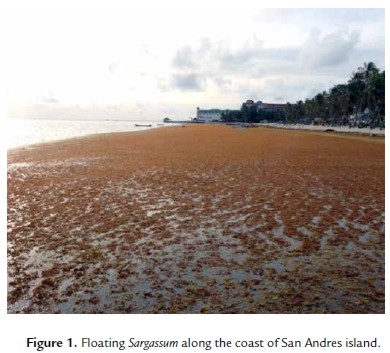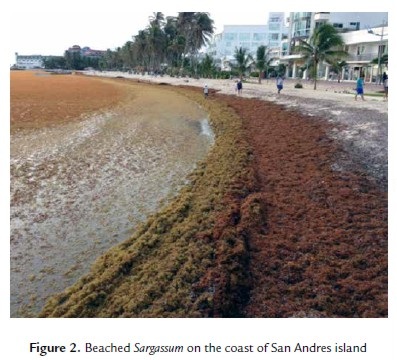Serviços Personalizados
Journal
Artigo
Indicadores
-
 Citado por SciELO
Citado por SciELO -
 Acessos
Acessos
Links relacionados
-
 Citado por Google
Citado por Google -
 Similares em
SciELO
Similares em
SciELO -
 Similares em Google
Similares em Google
Compartilhar
Acta Biológica Colombiana
versão impressa ISSN 0120-548X
Acta biol.Colomb. vol.20 no.1 Bogotá jan./abr. 2015
https://doi.org/10.15446/abc.v20n1.46109
Nota breve
MASSIVE QUANTITIES OF PELAGIC Sargassum ON THE SHORES OF SAN ANDRES ISLAND, SOUTHWESTERN CARIBBEAN
Cantidades masivas de Sargassum pelágicos en las costas de San Andrés Isla, Caribe suroccidental
Brigitte GAVIO1, M. Natalia RINCÓN-DÍAZ2, Adriana SANTOS-MARTÍNEZ3
1 Universidad Nacional de Colombia, sede Bogotá, Carrera 30 Calle 45. Departamento de Biología, edificio 421, oficina 106, Bogotá, Colombia.
2 Maestría en Ciencias, Biología, línea Biología Marina, Universidad Nacional de Colombia, sede Caribe, Vía a San Luis n. 52-44 San Andrés Isla, Colombia.
3Jardín Botánico, Harmony Hill Road, Universidad Nacional de Colombia, sede Caribe, San Andrés Isla, Colombia.
For correspondence. bgavio@unal.edu.co
Received 12th October 2014, Returned for revision 11th November 2014, accepted 13th November 2014.
Citation / Citar este artículo como: Gavio B, Rincón-Díaz M.N, Santos-Martínez A. Massive quantities of pelagic Sargassum on the shores of San Andrés Island, southwestern Caribbean. Acta biol. Colomb. 2015;20(1):239-241. Doi: http://dx.doi.org/10.15446/abc.v20n1.46109.
ABSTRACT
We report an unusual biomass of floating Sargassum, composed of the species S. fluitans and S. natans, that reached the northeastern coast of San Andres island in September 2014. The time and size of the event is unprecedented to the island.
Keywords: drifting algae, Sargassum, San Andres island, unusual biomass.
RESUMEN
Se reporta la llegada de una biomasa inusual de Sargassum flotante, compuesta por las especies S. fluitans y S. natans, a la costa nororiental de la isla de San Andrés. La época y el tamaño del evento nunca habían sido reportados anteriormente para la isla.
Palabras clave: algas flotantes, biomasa inusual, San Andrés isla, Sargassum.
Golden tides of pelagic Sargassum have been a recurrent event in the Caribbean Sea and the Gulf of Mexico, where great biomass of these algae is periodically washed ashore. The Sargasso Sea offshore the coast of Florida, has always been considered the source of this drift biomass beaching along the coastline of the Antilles and the Gulf of Mexico.
With the trade winds blowing in North-east to South west direction in the second part of the year, drifting algae coming from Sargasso Sea are a common event from September to January (Moreira and Alfonso, 2013).
Periodically, the volume of these floating algae has increased. For example, the increase of the golden tides during 1980s and 1990s in the Gulf of Mexico was associated to nutrification in the Gulf due to higher nutrient loads of the Mississippi river (Lapointe, 1995; Smetacek and Zingone, 2013).
Recently, it was demonstrated that floating Sargassum in the Gulf of Mexico does not come from the Sargasso Sea, instead it originates in the Gulf, and is then exported in spring to the Sargasso Sea, with an estimated biomass of one million tons wet weight transferred each year (Gower and King, 2011). In 2005, atypical quantities of Sargassum were observed in the Gulf of Mexico, it was such a biomass that 2005 was named the "Sargassum year" (Gower et al., 2013).
During spring and summer of 2011, anomalous quantities of pelagic Sargassum were washed ashore along the eastern coastline of the Caribbean Sea, and crossed the Atlantic to reach the coast of western Africa, from Sierra Leone to Ghana (Johnson et al., 2013; Smetacek and Zingone, 2013) in an unprecedented event. The peak biomass that year was 200-fold higher than the previous eight years' average biomass peak recorded in the Caribbean, while to man's memory, it was the first time drifting Sargassum reached the coast of Africa (Smetacek and Zingone, 2013).
Contrary to what was previously thought, satellite images showed that the origin of the floating algae was not the Sargasso Sea, but an area north of the estuary of the Amazon River, offshore the coast of Brazil (Johnson et al., 2013; Gower et al., 2013). This region had never been associated with Sargassum growth in the past, and, although the underlying causes of this anomalous event have not yet been elucidated, scientists suggest a link with global warming and perhaps nutrient load from the Amazon River (Johnson et al., 2013).
In 2012, Moreira and Alfonso (2013) reported an unusual Sargassum tide in the southern coast of Cuba. Although the authors mentioned that floating Sargassum periodically beaches along the island's coastline, the site and time of the year the drift algae were observed in 2012 were unusual.
San Andres Island lies in Southwestern Caribbean, about 280 km off the coast of Nicaragua. Its coast is periodically subjected to drifting algae during winter months, generally from November to January, when trade winds are strong and great amounts of drift are driven to the coast. The drift reaching the island is composed of seagrass species (Thalassia testudinum and Syringodium filiforme), which constitute the major biomass, and a diverse community of seaweeds, among which Sargassum natans and S. fluitans are present (Ortiz and Gavio, 2012).
During September 17th-20th of 2014, an unusual tide of Sargassum reached the northeastern coast of the island, covering an estimated of 32520 m2 (El Isleño, 2014).
The algae were identified as Sargassum fluitans and, with less biomass, S. natans. As reported in other locations, the biomass and timing of the drift reaching San Andres was unusual and not seen in the past decades. Meanwhile, reports of floating algae reaching the coastline of the Lesser Antilles have been documented between August and September of this year (Roffs, 2014). During the 2011 event, San Andres was not affected by the golden tide reaching both sides of the Atlantic.
The fact that these events have become recurrent, in the past three years, is alerting scientists as well as the affected communities, where tourism, fishing, and other economic activities have been disrupted. It is possible that nutrient loads are a likely cause, as it was suggested twenty years ago by Lapointe (1995). Although the origin of this 2014 event has not been identified yet, the drift in San Andres was observed shortly after the passage of hurricane Edouard (Sosnowski, 2014) towards the Atlantic coast of United States, and currents deriving from this atmospheric event may have blown seaweeds to San Andres Island.
Although in San Andres the Sargassum episode was short-lived and no major negative effects were observed on the nearshore coastal communities, it is urgent to understand the causes of these events, which may disrupt shallow ecosystems like seagrass and macroalgal beds, and affect local communities disrupting their economic activities.
AGRADECIMIENTOS
The authors wish to thank Ana Maria Alvarado and Jairo Urrego for their help in the field, and taking the photographs. Judith Castañeda and Paulina Ñustes transported the samples to Bogotá, for which we are grateful. Dr. Michael J. Wynne provided critical literature for which we acknowledge. The present contribution was supported by Universidad Nacional de Colombia, sede Caribe.
REFERENCES
El Isleño. 2014. Available at: http://www.xn--elisleo-9za.com/index.php?option=com_content&view=article&id=8320:coralina-algas-no-deben-generar-preocupacion&catid=41:ambiental&Itemid=83. [ Links ]
Gower JFR, King SA. Distribution of floating Sargassum in the Gulf of Mexico and the. Atlantic Ocean mapped using MERIS. Int J Remote Sens. 2011;32(7):1917–1929. Doi: 10.1080/01431161003639660. [ Links ]
Gower J, Young E, King S. Satellite images suggest a new Sargassum source region in 2011. Remote Sens Lett. 2013;4(8):764–773. Doi: 10.1080/2150704X.2013.796433. [ Links ]
Johnson DR, Ko DS, Franks JS, Moreno P, Sanchez-Rubio G. The Sargassum invasion of the Eastern Caribbean and dynamics of the Equatorial North Atlantic. Proceed 65th GCFI, Santa Marta, Colombia. 2013. p.102-103. [ Links ]
Lapointe BE. A comparison of nutrient-limited productivity in Sagrassum natans from neritic vs. oceanic waters of the Western North Atlantic Ocean. Limnol Oceanogr. 1995;40(3):625-633. Doi: 10.4319/lo.1995.40.3.0625. [ Links ]
Moreira A, Alfonso G. Inusual arribazón de Sargassum fluitans (Børgesen) Børgesen en la costa centro-sur de Cuba. Rev Invest Mar. 2013;33(2):17-20. [ Links ]
Ortiz JF, Gavio B. Notes on the marine algae of the International Biosphere Reserve Seaflower. II: diversity of drift algae in San Andrés Island, Caribbean Colombia. Caribb J Sci. 2012;46(2-3):313-321. [ Links ]
Roffs. 2014. Available at: http://www.roffs.com/2014/09/massive-quantities-pelagic-sargassum-washing-along-caribbean-shorelines/?utm_source=ROFFS+NEWSLETTER+13352&utm_campaign=b3c0601f76-ROFFS_Fishy_Times_Newsletter_38thEdition10_01_2014&utm_medium=email&utm_term=0_a2ccced3dcb3c0601f76-95404457. [ Links ]
Smetacek V, Zingone A. Green and golden seaweed tides on the rise. Nature. 2013;504:84-88. Doi: 10.1038/nature12860. [ Links ]
Sosnowski A. Edouard to Send Rough Surf to US East Coast. AccuWeather.com. 2014. Available at: http://www.accuweather.com/en/weather-news/tropical-depression-on-verge-o/33834459. [ Links ]















